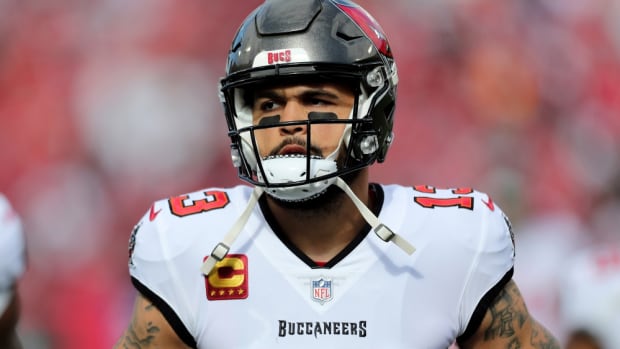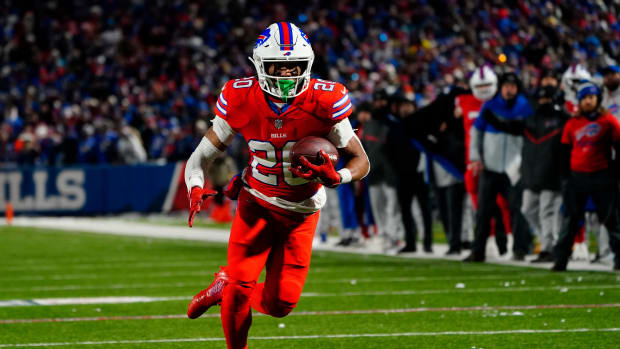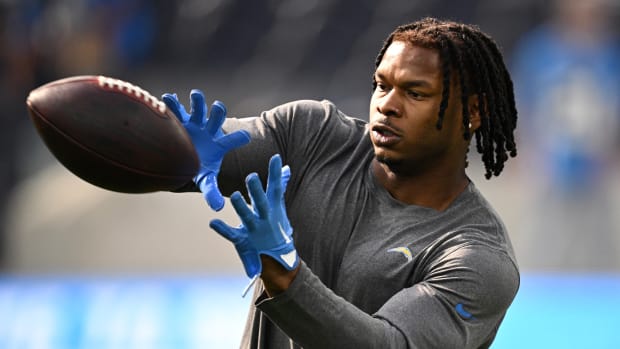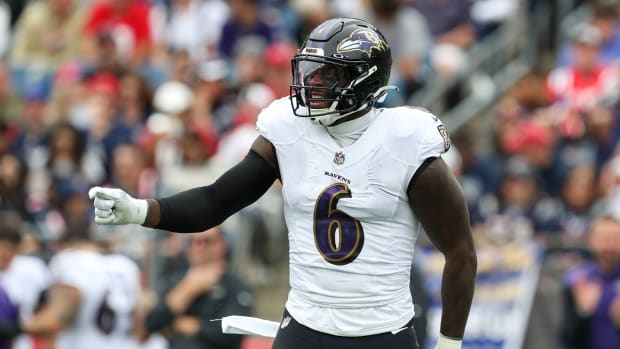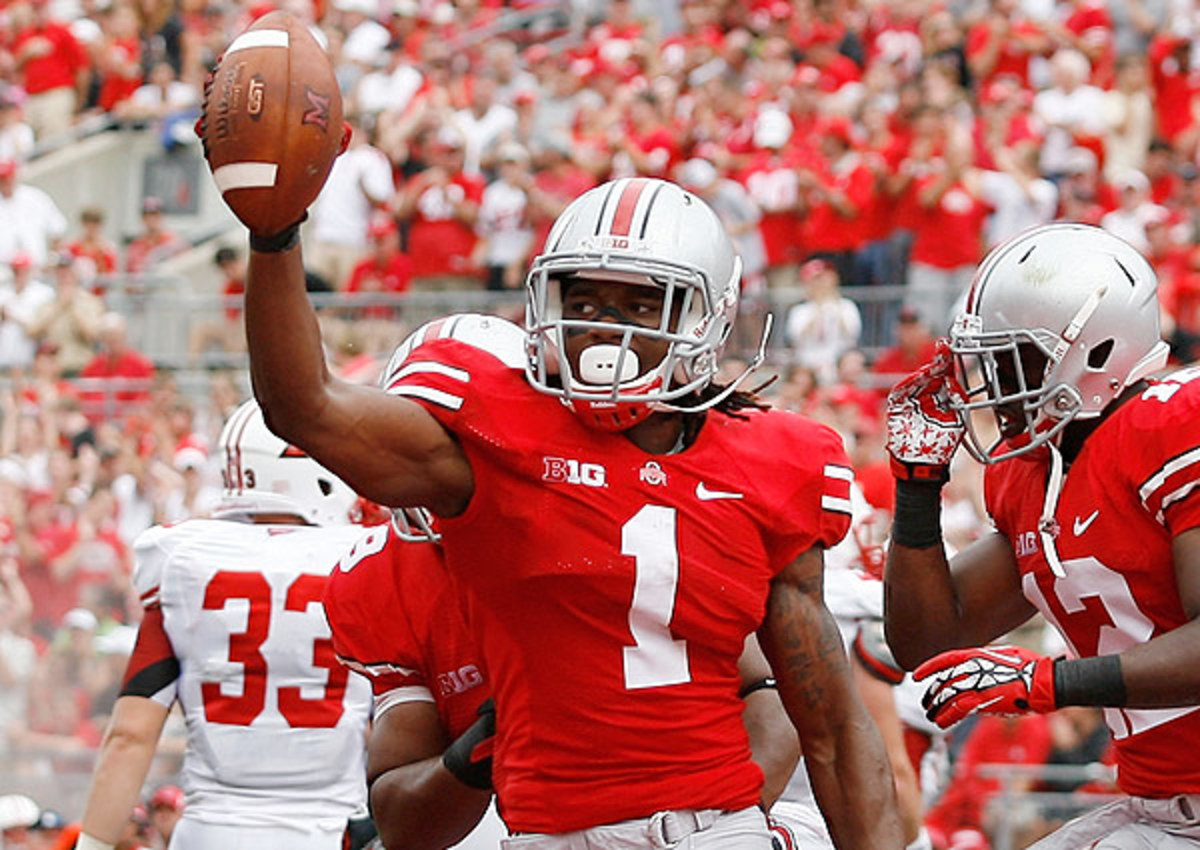
Burning questions for 2014 combine
A speedster who is a legitimate threat to run the fastest 40 time, Bradley Roby could be a serious riser this week. (Kirk Irwin/Getty Images)
Fortunes will rise and fall this week at the 2014 scouting combine in Indianapolis. Who has the most to gain? Which player has the most to lose? Chris Burke and Doug Farrar break down the burning questions.
Who will see their stock rise most at the combine?
Chris Burke: Bradley Roby, CB, Ohio State. The former Buckeye did not have near the season most expected him to have, but the combine will provide him the opportunity to remind everyone why he was so highly thought of in the first place. Specifically, that he's a tremendous athlete (and most definitely a candidate to post the fastest 40 time, which is a topic to come here). Roby's junior tape is impressive -- he easily could have made the jump to the NFL after the 2012 season. Combine that previous brilliance with a strong combine and he'll be solidly back in the Round 1 discussion.
Doug Farrar: You could go in all sorts of directions with this question, but the thing I always look forward to most is that you'll see a lot of smaller-school guys really hit it big during combine week. This happens every year, and there are always a few players who come out of nowhere and cement their status as real NFL players. This year, I would keep an eye on Lindenwood cornerback Pierre Desir, Louisiana Tech defensive tackle Justin Ellis, Western Kentucky linebacker Andrew Jackson, Bloomsburg defensive end Larry Webster, Eastern Illinois quarterback Jimmy Garoppolo, Towson running back Terrance West and Saginaw Valley State receiver Jeff Janis as a few of those potential players.
Who will see their stock drop most at the combine?
Burke: Ka'Deem Carey, RB, Arizona. Carey's been training to bring his 40 time down this week, so call it a hunch that he won't blow anyone away. The running back position might be as volatile as any when it comes to this year's draft prospects, and though Carey sits at or near the top of a lot of experts' boards, others are not nearly as high on his game. A red flag like a plodding 40 time would be enough to dip him several spots.
Farrar: Again, in a general sense ... anyone who doesn't play ball (both literally and figuratively) with the NFL during the week. If you try to hide things during interviews, odds are, someone in the NFL will find out. If you're an on-the-bubble prospect and decline to participate in drills for any reason other than injury, that bubble will burst rather quickly. If you don't admit straight up that you've smoked marijuana recently (which probably isn't as big a deal to most teams as it used to be), that's going to hurt you, too. Most teams will look at youthful indiscretions as such, and what they want to see is a player interested in fully participating in this process, and telling the truth along the way. It sounds mind-numbingly simple, but remember how many prospects each team has to check on. There's a great deal of value in a proactive approach when you're at the combine.
What's more important for Michael Sam in Indy: interviews or on-field drills?
Burke: Interviews. Sam is what he is right now as a football player: a plus athlete with technique issues. Nothing that happens on the field for him this week will upgrade or downgrade him significantly. The interview process, on the other hand, will be trying and tedious, even if teams approach him cautiously. He needs to continue to show the poise he's displayed thus far.
Farrar: Interviews. Teams have been watching Sam on tape for a long time now, and though there may be an outlier team or two out there, most analysts see Sam as a third-day pick (late second-day at best) based on pure NFL potential. And that jibes with what I see on tape. Sam has obvious physical limitations that will decide his fate based on team and scheme.
What teams will want to know now is how Sam has prepared himself to deal with a media and perception furor no NFL player has ever seen before. In that regard, I would say that the team interviews for Sam will be as important as the first meeting Branch Rickey had with Jackie Robinson, when Rickey put Robinson through the wringer to see what he could handle, and that he would respond the ways in which he needed to.
Should Johnny Manziel, A.J. McCarron and others be throwing at the combine?
Burke: Yes. I get the reasoning behind sitting out those drills -- an awkward environment with unfamiliar receivers sets the stage for a poor showing -- but there's not enough downside for me to ever get behind a QB skipping out. Making too much of a big deal of this either way is a mistake, as scouts will base their evaluations on college performance plus what they see in later workouts. Still, I'd argue that it shows at least a semblance of mental weakness to bail this week, when the eyes of the football world are watching closely.
Farrar: Yes. Unless you're injured, or ironing out some huge mechanical flaw, I don't think it's ever a good idea to avoid throwing at the combine. As much tape as teams have on these quarterbacks, the combine throwing drills allow those teams to see their potential future signal-callers in new environments. And the willingness to do those drills could alter perceptions positively enough to affect draft stock.
Whether it's Teddy Bridgewater, Johnny Manziel, or anyone else in this particular draft class, no quarterback this year is a lead-pipe lock enough to avoid throwing. Blake Bortles' last-minute decision to get on the field at Lucas Oil and go through the drills was a wise one. We'll see if that changes anyone else's mind. In a case like McCarron's ... well, he can use all the help he can get with the perception that he's a limited player who was propped up by the talent around him. McCarron already passed up on the Senior Bowl, and he's evidently on the fence about whether he'll throw. Teams might start to wonder what he's afraid of. And in the pre-draft process, perception is just as important as reality, if not more so.
Who will run the fastest 40 time?
Burke: Dri Archer, RB, Kent State. There's a scene in the movie Miracle where the Craig Patrick and Herb Brooks characters are discussing Brooks' choice of Jim Craig as a goalie on the roster.
"You know," Patrick says, "people say that Craig's game has been off since his mom died."
Brooks responds: "They ever see him when his game's on?"
And that's kind of how I feel about Archer's injury-plagued 2013 season. When a fully healthy Archer has taken the field (mainly in 2012 and prior), he's been an electrifying force. Assuming he is 100 percent this week, expect him to burn up the Lucas Oil Stadium turf. And because of that, Archer actually belongs in the "rising stock" conversation, too.
Farrar:
Bradley Roby, CB, Ohio State.


































